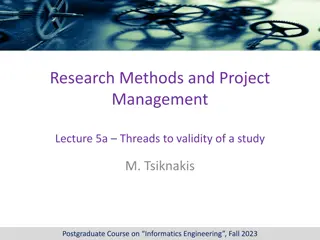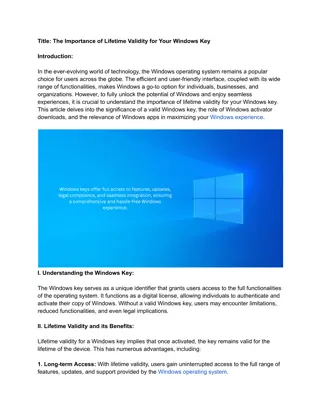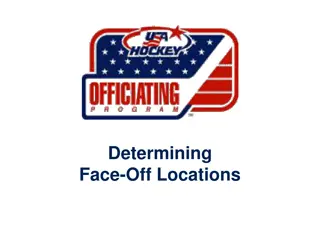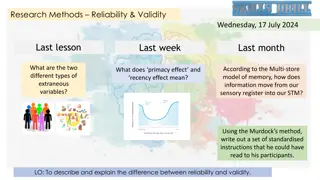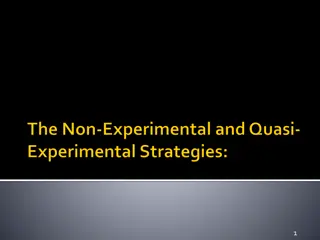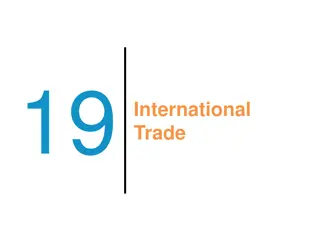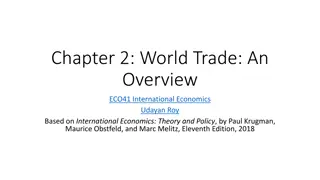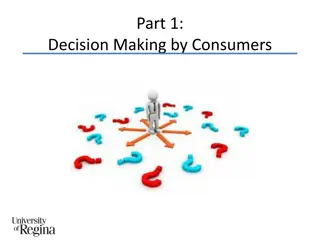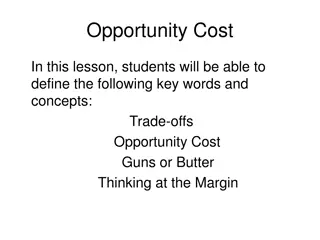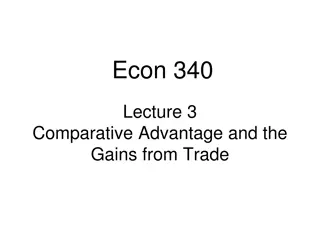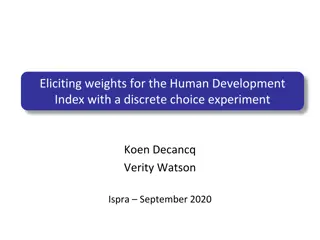Understanding Experimental Design and Validity Trade-offs in Research
Explore the concepts of experimental design, trade-offs in research validity, causal relationships, evidence, and controls in experiments. Delve into lab and field experiments, manipulation of variables, controls, and the importance of causal evidence in research. Consider the impact of extraneous factors, agreement between variables, and the significance of causal relationships in empirical research.
Download Presentation

Please find below an Image/Link to download the presentation.
The content on the website is provided AS IS for your information and personal use only. It may not be sold, licensed, or shared on other websites without obtaining consent from the author. Download presentation by click this link. If you encounter any issues during the download, it is possible that the publisher has removed the file from their server.
E N D
Presentation Transcript
7 Experimentation: Lab Experiments and Field Experiments Department of Information Management CYCU CK Farn mailto: ckfarn@gmail.com 2023.11 Updated
Empirical Research Design Lab Experiment Quasi Experiment Field Experiment Simulated Experiment Pre- Experiment Experiment Manipulation of x Empirical Research Document analysis Content analysis Measuring of x Survey Case study Ex post Facto Ethnography Observation Participant observation Artifact analysis CK Farn, CYCU 2
Trade-offs among validities Academic research Internal > Construct > Statistical Conclusion > External Practical research, applied research Internal > External > Construct (of the Y) > Statistical Conclusion > Construct (of the X) The researchers should make conscious trade-offs among different types of validities For example, should I use students as informants (low cost, high feasibility, high internal validity, low external validity); or use real employees (high cost, low feasibility, low internal validity, high external validity) CK Farn, CYCU 3
Causal Relationship Cause leads to effects (outcome) Manipulate the cause With extraneous/confounding factors Control the extraneous factors CK Farn, CYCU 4
Causal Evidence Agreement between Xs and Ys Time order of occurrence Extraneous variables did not influence Ys CK Farn, CYCU 5
Experiments can be conducted in Laboratories (Lab or true experiments) Strong control over many factors In science lab, we control temperature, humidity, atmospheric pressure, lightning, . Lab experiments Real-world settings (Quasi or field experiments) Extraneous cannot be well controlled Field experiments, Quasi experiments Computer simulation CK Farn, CYCU 6
Controls in experiments Experimental group Manipulations are administered e.g. newly developed vaccine ( ) injected Control group A group for making comparisons All other conditions are the came: controlled e.g. fake vaccine (placebo ) injected Other controls Ensure that no other confounding factors contaminating the experiment CK Farn, CYCU 7
Laboratory Experiments Conducted in a well controlled laboratory setting The lab setting is different from the real world Eliminate, as much as possible, extraneous factors and potential threats to validity Sacrifices external validity, while maximizing internal validity Manipulating the independent variable, then measuring the dependent variable Strong causal relationship: internal validity. Manipulating X, thus ethical considerations need to be taken into account Controlling possible extraneous factors Measuring the dependent variable and other variables CK Farn, CYCU 8
Advantages of Lab Experiments Determined causal relationship Eliminating contamination from extraneous variables Convenience and low costs Can easily be replicated and repeated Can makes use of natural phenomena CK Farn, CYCU 9
Disadvantages of Lab Experiments Artificial lab setting In a lab, samples are not making real decisions Certain samples may introduce bias Students instead to business managers Costs may be higher Certain costs in simulating the real settings More effective for contemporary issues Usage of smart phones Ethical concerns in manipulation Treating patients with placebo ( ) CK Farn, CYCU 10
Conducting an Experiment Specify treatment variables (X) Specify treatment levels Control environment Choose experimental design Select and assign participants Pilot-test, revise, and test Collect data Analyze data CK Farn, CYCU 11
Lab and Field Experiments Field Lab Artificial settings - unreal Natural settings Few confounding factors Uncontrolled extraneous factors Tight controls Loose control Low cost High cost Duration short Duration long Samples are aware Sample may not aware CK Farn, CYCU 12
Experiment: Placement of Benefits Module CK Farn, CYCU 13
Measurement Options Observation Physiological measures Paper-and-pencil tests Options Self- Scaling techniques administered instruments CK Farn, CYCU 14
Validity in Experimentation Internal External CK Farn, CYCU 15
Threats to Internal Validity Maturation History Experimental mortality Testing Threats Statistical regression Instrumentation Selection CK Farn, CYCU 16
Threats to External Validity Representativeness of samples Students as samples But, in cases of on-line learning it may be OK CK Farn, CYCU 17
Additional Threats to Internal Validity Diffusion of treatment Compensatory equalization Compensatory rivalry Resentful disadvantaged Local history CK Farn, CYCU 18
Experimental Research Designs Pre-experiments True experiments Field experiments CK Farn, CYCU 19
Selecting and Assigning Participants Random assignment Matching CK Farn, CYCU 20
Matched assignment: Quota Matrix Example CK Farn, CYCU 21
X: manipulation O: observation R: random assignment M: matched pair assignment CK Farn, CYCU 22
Pre-experimentation (One-Shot) After-Only Case Study X O No control group! CK Farn, CYCU 23 Pre-experiment
One Group Pretest-Posttest Design O1 X O2 No control group! CK Farn, CYCU 24 Pre-experiment
Static Group Comparison X O1 O2 Pre-experiment CK Farn, CYCU 25
True Experimentation Posttest-Only Control Group Design Experimental group R X O1 R O2 Control group CK Farn, CYCU 26 True experiment
Pretest-Posttest Control Group Design R O1 X O2 R O3 O4 Effect= (O2- O1) vs (O4- O3) Deal well with the major internal validity problems Maturity threats CK Farn, CYCU 27 True experiment
Pretest-Posttest Control Group Design 2 Completely Randomized Design E.g., 3 treatment levels R R R O1 O3 O5 X2 X3 X5 O3 O4 O6 CK Farn, CYCU 28
Pretest-Posttest Control Group Design 3 Matched pair Design E.g., 3 treatment levels M M M O1 O3 O5 X2 X3 X5 O3 O4 O6 CK Farn, CYCU 29
Pretest-Posttest Control Group Design 4 Randomized Block Design Blocking Factor High X1 X2 X3 Manioulation Factor Condition 1 Medium X1 X2 X3 Low X1 X2 X3 R R R Condition 2 Condition 3 CK Farn, CYCU 30
Pretest-Posttest Control Group Design 5 Latin Square Design Customer Income Medium X1 X3 X2 Store Size Large Medium Small High X3 X2 X1 Low X2 X1 X3 This is a design seldom used, difficult to conduct statistical analysis CK Farn, CYCU 31
Pretest-Posttest Control Group Design 6 Factorial Design Price Spread Unit price information? 7 Cents Yes No 12 Cents X1Y2 X2Y2 17 Cents X1Y3 X2Y3 X1Y1 X2Y1 Covariance Analysis CK Farn, CYCU 32
Field Experiments: Quasi- or Semi-Experiments Non Equivalent Control Group Design Separate Sample Pretest-Posttest Design Group Time Series Design CK Farn, CYCU 33
Nonequivalent Control Group Design O1 X O2 O3 O4 No random assignment to groups - Problem with selection - Uncontrollable contamination CK Farn, CYCU 34 Field experiment
Separate Sample Pretest-Posttest Design O1 (X) X O2 CK Farn, CYCU 35 Field experiment
Group Time Series Design O1O2O3X O4 O5 O6 O7O8O9 O10O11O12 CK Farn, CYCU 36 Field experiment
Job Enrichment Quasi-experiment CK Farn, CYCU 37
Main effects and moderating effects Main effect The influence of a single independent variable on a dependent variable. Interaction effect The influence on a dependent variable by combinations of two or more independent variables. CK Farn, CYCU 38
2 x 2 Factorial Design Ad A Ad B Men 65 55 75 Main Effects of Gender > 85 45 Women 65 70 60 Main Effects of Ad CK Farn, CYCU 39
Interaction: Moderating effects 100 90 80 70 60 50 40 30 20 10 Ad A Ad B CK Farn, CYCU 40
Strongest design: Lab Experiment Extraneous factors can be mostly excluded In general, high internal validity Strong conclusion in causal relationship Criticism Samples are unrelated to the real world Weak in external validity In cases of systems development Conduct experiments with simulation CK Farn, CYCU 41
Assignment #6A You have a choice between this assignment and the assignment for survey research in class note #8 Read the paper: https://onlinelibrary.wiley.com/doi/pdf/10.1002/mar.20120 Classify its experimental design What are the major design considerations to exclude the threads of validity Discuss on its internal and external validities Prepare a short ppt document, no more that SIX pages File name: HW6A_SID_Name.ppt Upload your ppt file to https://mega.linkin.tw/index.php/s/f2Z5zf2Br9rWgmS CK Farn, CYCU 42



